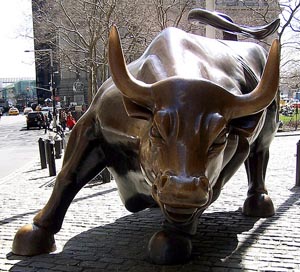Here are a few of the data stories that caught my eye this week.
Will big data make the stock exchange obsolete?
 That’s the question asked by Andy Kessler in a story titled “Is Internet Cloud and Big Data Killing Stock Exchanges? The New Network Is Virtual.” Kessler points to several interesting forces at play that may be undermining the necessity for stock exchanges — or at least stock exchanges as we know them. Technology, he contends, has rendered the traders shouting out on the NYSE floor obsolete:
That’s the question asked by Andy Kessler in a story titled “Is Internet Cloud and Big Data Killing Stock Exchanges? The New Network Is Virtual.” Kessler points to several interesting forces at play that may be undermining the necessity for stock exchanges — or at least stock exchanges as we know them. Technology, he contends, has rendered the traders shouting out on the NYSE floor obsolete:
[W]e need markets. But we barely need humans and traditional exchanges anymore to implement these markets. And certainly not inside a building, as voices now carry to the far reaches of the globe in 300 milliseconds, and even that’s considered too slow. Trading on Wall Street is just plumbing these days. Value is added much further up the food chain. Trades take place on servers in the great data cloud in the sky. A third of trading even takes place in so-called Dark Pools, privately owned servers that match institutional orders without ever revealing the size or price of the order. Technology has rendered the stock exchange as we know it obsolete.
Kessler argues that today, “speed is everything,” and even though the “flash crash” of May 2010 demonstrated some of the dangers of automated trading, we are likely moving away from human-operated exchanges.
(See also: Trading on sentiment — Sentiment analysis gives algorithmic trading an edge.)
 OSCON Data 2011, being held July 25-27 in Portland, Ore., is a gathering for developers who are hands-on, doing the systems work and evolving architectures and tools to manage data. (This event is co-located with OSCON.)
OSCON Data 2011, being held July 25-27 in Portland, Ore., is a gathering for developers who are hands-on, doing the systems work and evolving architectures and tools to manage data. (This event is co-located with OSCON.)
The data black market: Sony and stolen credit card data
With a number of high profile database breaches as of late, it’s no surprise that many of the news stories addressing the topic of data are concerned with consumers’ privacy and security. A recent post in The New York Times is no exception. “How Credit Card Data Is Stolen and Sold looks at the recent attack on the Sony Playstation Network and the implications of the massive amount of stolen credit card information — not just on consumers, but on the black market for such data.
“According to a number of security researchers,” writes Nick Bilton, “the sale of stolen information and credit cards often takes place completely underground in secret credit forums, where hackers exchange or sell data. These forums are closed to the public, and people who join the groups are vetted by forum administrators to ensure they are not from law enforcement.” The story goes on to suggest that the possible influx of millions of credit card numbers — there have been boasts of over 2.2 million numbers stolen from Sony — will flood the black market and lower prices.
No doubt, security breaches certainly need to be taken seriously, but so does the mainstream media’s treatment of hackers and marketplaces for data.
(See also: Anatomy of a phish — In light of recent security snafus, it’s worth reviewing the basics of phish detection and prevention.)
The predictive power of geography undergraduate students
News that U.S. Special Forces had shot and killed Osama Bin Laden came as a surprise announcement Sunday night. But the location of Bin Laden’s hideout may not have seemed like such a shock to UCLA geography professors Thomas Gillespie and John Agnew. Working with a a class of undergraduate students, the professors published a paper in 2009 predicting Bin Laden’s whereabouts. According to the probabilistic model they created, there was an 88.9% chance that Bin Laden was hiding out in the region in which he was eventually found.
According to Science Insider, the Bin Laden tracking effort initially began as an undergraduate class project. Using remote sensing data from satellites and reporting on Bin Laden’s movements since his last known location, students devised a model predicting where he was likely to be. They predicted he would be found in a town, based on a geographical theory called island biogeography. “The theory was basically that if you’re going to try and survive, you’re going to a region with a low extinction rate: a large town,” Gillespie said in the article. “We hypothesized he wouldn’t be in a small town where people could report on him.”
The undergraduates’ project was so well done that Gillespie says he wrote up the results and submitted the paper to the MIT International Review. Other researchers were skeptical of the students’ predictions and thought they were “overconfident” in predicting the location down to specific buildings.” No word, of course, on whether the Navy Seals read academic geography journals.
Got data news?
Feel free to email me.
Photo: Bull at the New York Stock Exchange by Walter Rodriguez, on Flickr
Related:
